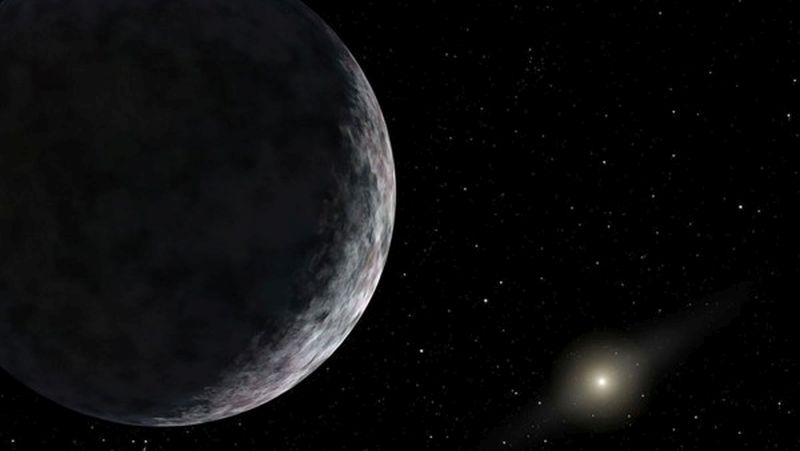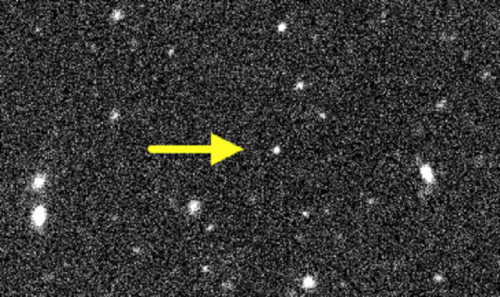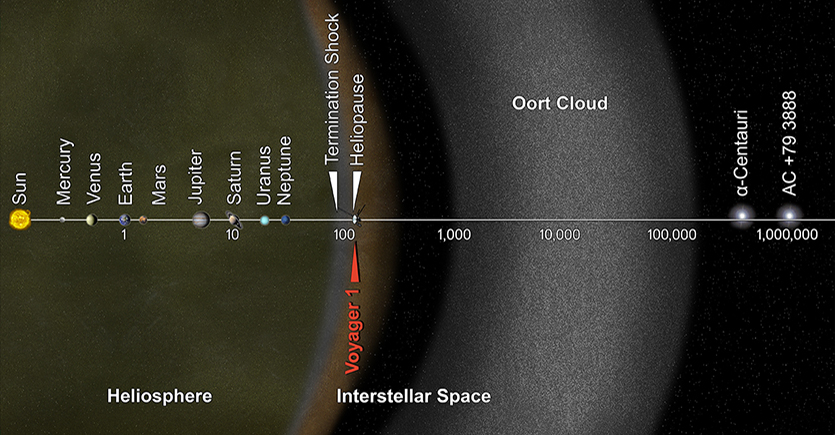
Far from being an empty expanse of space in the deep reaches of the outer Solar System, the Kuiper Belt is a vast reservoir of hundreds of thousands of icy planetesimals which extends between the orbits of Neptune and Pluto, in an area approximately between 30 and 50 Astronomical Units from the Sun. It has long been hypothesized since the 1950’s that the Kuiper Belt didn’t mark the outer boundaries of the Solar System however, with astronomers believing that a much larger spherical cloud composed of trillions of comets envelopes the Sun out to a distance of 50,000 AU away or even further. This hypothesized envelope, better known as the Oort Cloud, had remained just a theoretical notion for decades until the discovery of Sedna in 2003, a large 900-km-wide minor planet whose widely elongated orbit ranges between 76 and 937 AU from the Sun. A second such object, named 2012 VP113, which was first spotted in 2012, was found to have a perihelion of 80 AU, even larger than Sedna’s, suggesting that these two bodies might be members of the long-hypothesized Oort Cloud.
Now, a team of astronomers has announced the discovery of a third similar object at similar distances, indicating that a population of icy bodies lies far beyond the Kuiper Belt, which might be perturbed by the gravity of an unseen massive planet that could be lurking even further out.

The newly found object, which has been given the standard nomenclature name V774104, was first spotted by a team of planetary scientists, led by Scott Sheppard, an astronomer at the Carnegie Institution for Science’s in Washington, DC and Chadwick Trujillo, an assistant astronomer of the Gemini Observatory in Hawaii. During an observing campaign for new trans-Neptunian objects utilising the 8.2-meter Subaru Telescope on Mauna Key and the Dark Energy Camera mounted on NOAO’s 4-meter Víctor M. Blanco Telescope in Chile, the researchers noticed last month a previously unseen bright speck of light moving slowly relative to the background stars.
By these observations alone Sheppard’s team could not infer much about the orbit of V774104, yet by its relative movement, the astronomers concluded that it was 800 to 1,000 km wide, roughly half the size of Pluto and was located approximately 103 AU away. “We don’t know anything about its orbit,” Sheppard told New Scientist, following the presentation of his team’s findings at the 47th Annual Meeting of the American Astronomical Society’s Division for Planetary Sciences, which takes place this week between 8-13 November in Washington, DC. “We just know it’s the most distant object known.”
Sheppard and Trujillo aren’t new-comers to the field of trans-Neptunian objects, having already established their names by taking part in past major discoveries like that of Eris, Sedna and 2012 VP113, among others. The latter two in particular exhibit orbits which bring their closest point to the Sun far beyond the orbit of Neptune, prompting many astronomers to hail them as possible members of the long-sought-for Oort Cloud. More credence to this hypothesis could be given by establishing the exact orbit of V774104 as well, something that Sheppard’s team expects to achieve within the next year.
If it is established that V774104 has a perihelion close to the orbit of Neptune, that would most likely make it an obscure member of the Kuiper Belt, but if its orbit is found to be similar to that of Sedna and 2012 VP113, that would mean that it’s unrelated to the Kuiper Belt and is instead the third member of the family of ‘Sednoids’ to be detected after Sedna and 2012 VP113, which are regarded as belonging to the inner Oort Cloud.
Whatever the case, the Sednoids present a major challenge for astronomers, for their widely eccentric orbits don’t really fit with the predictions of established theoretical models regarding the dynamical evolution of the Solar System – they lie too far from Neptune to have been gravitationally influenced by it and are too close to the Sun to have been perturbed by the close passage of nearby stars.

“We can’t explain these objects’ orbits from what we know about the Solar System,” says Sheppard.
One of the possible explanations that have been put forth is that the orbits of the Sednoids are a relic from the earliest days of the Solar System, when neighboring stars close to the young Sun altered the orbits of objects within the Oort Cloud. Yet, another hypothesis posits that the latter were perturbed by the gravity of a massive planet that was eventually kicked out of the early Solar System by the outward migration of Jupiter or Neptune. A series of theoretical studies in recent years have shown that such a massive planet might still lie in the dark beyond the Kuiper Belt, whose gravity is shaping the orbits of Sednoids, as well as that of V774104.
“Something might be shepherding the objects,” Sheppard says.
For the time being however, the exact identity of V774104 remains unknown. Whatever the answer, the newly discovered object is bound to teach astronomers much about the evolution of the Solar System, either by shedding more light to the role that neighboring stars might have played early on in its history, or uncovering more tantalising evidence for the existence of still unknown planets in the outer reaches of the Solar System. Either way, V774104 is the new record holder for the most distant Solar System object known to date. “I have held the record for 10 years,” jokes Mike Brown, a professor of astronomy at the California Institute of Technology, who discovered the dwarf planet Eris (and previous record-holder) in 2005. “I have to relinquish it. So I’m sad.”
Be sure to “Like” AmericaSpace on Facebook and follow us on Twitter: @AmericaSpace
.






Our family of planets in the solar system may very well be the “tip of the iceberg.” Continued examination of the region beyond the Kuiper Belt promises untold exciting discoveries. We live in interesting times!
When HP Lovecraft originally wrote “Fungi From Yuggoth,” he associated the mysterious planet in the outer fringes of the Solar System with newly-discovered Pluto, which was thought to be quite large. When Pluto turned out to be much smaller than expected, smaller even than some of the Gallilean moons of Jupiter, it no longer seemed to be the model for Yuggoth, although names from the Lovecraft Mythos have been used for some of the newly-discovered features of Pluto. However, it would be neat to discover that there is a massive planet out beyond what we usually consider the outermost fringes of the Solar System — except would such a body beyond the Oort Cloud still be under the gravitational influence of the Sun, or would it be moving on its own, independent orbit around the black hole at the Milky Way’s core?
Our Sun’s gravitational dominance goes out to about 1 light year. Beyond that other stars and the galaxy as a whole have greater gravitational dominance.
I had to look it up but the sun’s influence of to 1 light year is = 63,241.1 AU, or about halfway across the Oort Cloud as depicted in the figure included in the article. Can someone comment on that figure showing the Oort Cloud out to 100,000 AU if the sun’s dominance end week before that?
Also with the all sky infrared survey performed by the WISE spacecraft mission it seems unlikely that there is a cold, dark planet hiding in the Kuiper Belt or the Oort Cloud. I’m not understanding the basis for those comments. Please elaborate if I am missing something. Thx.
Hello Jim,
As Jester points out, the force of gravity from an object in space extends infinitely. There’s not a point where it stops abruptly, it just gets weaker with increasing distance from the former. The Sun’s gravitational influence is thought to become weak enough at a distance between 1 and 2 light years away where the gravity from the galactic center begins to take over.
As for the sky survey from WISE, it was sensitive enough to detect a Jupiter-sized gas giant out to a distance of 26,000 Astronomical Units from the Sun, but it found none. That doesn’t preclude the possibility that a smaller planet in size could still exist out there. If it does, WISE would not have been able to detect it.
Hi Jim,
Strictly speaking, if you calculate the Sun’s Hill Sphere with respect to the Centauri system, it goes out to about 2.3 light years. However, it’s actually a very complex situation. The Hill Sphere of the Sun is not a perfect sphere, but is lumpy, due to multiple gravitational fields from multiple nearby stars at varying distances and many different directions, and also the gravitational field of the galaxy as a whole must be considered.
Also keep in mind, while the Centauri system is the closest star system to our Sun now, that was not always true. There have been multiple flybys of stars in our neighborhood over the past few hundred thousand years and there will be closer flybys of other stars in the future. So the Sun’s area of gravitational dominance is constantly in flux, and these flybys also would have a significant effect on the orbits of objects very far away from the sun.
So, while the Oort cloud does theoretically extend to some 100,000 AU distance or so, there’s probably no long-term stable orbits further out than about 1 light year.
I kept my answer simple in order to answer the original question directly.